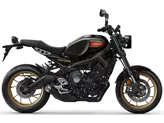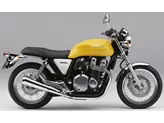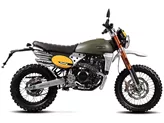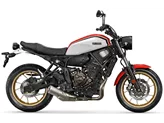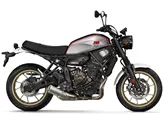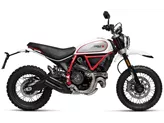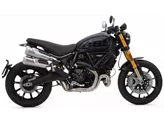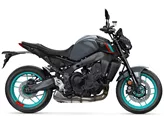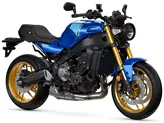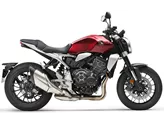Ducati Scrambler Desert Sled 2017 vs. Yamaha XSR900 2016

Ducati Scrambler Desert Sled 2017

Yamaha XSR900 2016
Overview - Ducati Scrambler Desert Sled 2017 vs Yamaha XSR900 2016
The Ducati Scrambler Desert Sled 2017 and the Yamaha XSR900 2016 are both naked bikes that offer unique features and characteristics.
Starting with the engine and drive train, the Ducati Scrambler Desert Sled is equipped with a V-twin engine that delivers 73 horsepower and 67 Nm of torque. On the other hand, the Yamaha XSR900 boasts an inline three-cylinder engine that produces a more powerful 115 horsepower and 87.5 Nm of torque. Both bikes have a different engine configuration, with the Ducati having a V-twin and the Yamaha having an inline three-cylinder.
In terms of cooling, the Ducati Scrambler Desert Sled relies on air cooling, while the Yamaha XSR900 uses liquid cooling. This difference in cooling systems can affect the overall performance and temperature management of the bikes.

Ducati Scrambler Desert Sled 2017
The suspension setup for both bikes is similar, with upside-down telescopic forks in the front and a swing arm with a monoshock in the rear. This suspension configuration provides good handling and stability for both on-road and off-road riding.
The chassis of the Ducati Scrambler Desert Sled is made of steel, while the Yamaha XSR900 features an aluminum frame. The choice of materials can impact the overall weight and rigidity of the bikes, with aluminum frames generally being lighter and more rigid than steel frames.
When it comes to braking, the Ducati Scrambler Desert Sled has a single disk front brake with a diameter of 330 mm, while the Yamaha XSR900 has double disk front brakes with a diameter of 298 mm. Both bikes are equipped with ABS as standard, providing advanced rider assistance systems for improved safety.
In terms of dimensions and weights, the Ducati Scrambler Desert Sled has a front tire width of 120 mm and a diameter of 19 inches, while the Yamaha XSR900 has a front tire width of 120 mm and a diameter of 17 inches. The rear tire width for the Ducati is 170 mm with a diameter of 17 inches, while the Yamaha has a wider rear tire width of 180 mm with the same diameter of 17 inches. The wheelbase of the Ducati is 1585 mm, while the Yamaha has a shorter wheelbase of 1440 mm. The seat height of the Ducati is higher at 860 mm compared to the Yamaha's seat height of 815 mm. The Ducati also has a higher kerb weight of 207 kg, while the Yamaha weighs slightly less at 191 kg. Both bikes have a fuel tank capacity of around 13.5-14 liters.

Yamaha XSR900 2016
Now, let's discuss the strengths and weaknesses of each bike. The Ducati Scrambler Desert Sled stands out with its cool look, cultivated engine, robust appearance, good brakes, and suitability for off-road use. However, it lacks handguards as standard and the seat height may be too high for smaller riders.
On the other hand, the Yamaha XSR900 impresses with its powerful engine, well-tuned riding modes, ABS and TC as standard, authentic modern design, and clean workmanship. However, it has a hard chassis, the seat could be more comfortable, and the speedblock design is already found on many other models.
In summary, the Ducati Scrambler Desert Sled 2017 and the Yamaha XSR900 2016 are both unique naked bikes with their own strengths and weaknesses. The Ducati offers a rugged off-road capability and a cool aesthetic, while the Yamaha provides a powerful engine and modern design. Ultimately, the choice between the two will depend on the rider's preferences and priorities.
Technical Specifications Ducati Scrambler Desert Sled 2017 compared to Yamaha XSR900 2016
Pros and Cons in comparison
Pros and Cons in comparison
Ducati Scrambler Desert Sled 2017

The Desert Sled is not made for tough off-road use, but for fun sessions on gravel roads and in light terrain. With its reinforced frame, large 19" front wheel and fully adjustable suspension elements, it takes into account the requirements of its new field of use. The seat height of 860 millimetres (840 millimetres with a lower seat) also suggests that off-road excursions are not completely absurd. The Ducati Scrambler Desert Sled is just the same, but without ignoring the spirit of lifestyle. Fortunately, the headlight grille of the new Scrambler is homologated, as are the high mudguards.
Yamaha XSR900 2016

The XSR900 combines the performance of a sporty streetfighter with the look of a pleasing, cleanly finished retro naked bike. In doing so, the Japanese make use of their own history, which can be found bundled and without gaps in the archive of the design agency that has been working for Yamaha for 60 years. It adopts the virtues of the MT-09 and has mended some of its weaknesses. It rides more harmoniously, more controlled and, if desired, more relaxed. Only the comfort, and thus the rider, suffers from the tight chassis on bad roads. You have to be a little bit sensitive when it comes to a neo-classic.
Price Comparison Avarage Market Price Ducati Scrambler Desert Sled vs Yamaha XSR900
There are a few key differences between a Ducati Scrambler Desert Sled 2017 and a Yamaha XSR900 2016. In terms of price, the actual average price of a Ducati Scrambler Desert Sled 2017 is about 29% higher. A Ducati Scrambler Desert Sled 2017 experiences a loss of 770 GBP in one year and 1,190 GBP in two years of ownership. This is offset by a loss of 1,680 GBP and 1,690 GBP for a Yamaha XSR900 2016. Compared to Yamaha XSR900 2016 there are more Ducati Scrambler Desert Sled 2017 bikes available on the 1000PS.de Marketplace, specifically 11 compared to 5. It takes less time to sell a Yamaha XSR900 with 77 days compared to 96 days for the Ducati Scrambler Desert Sled. Since model year 2017 1000PS.de editors have written 9 reviews for the Ducati Scrambler Desert Sled and 30 reviews for the Yamaha XSR900 since model year 2016. The first review for the Ducati Scrambler Desert Sled was published on 07/11/2016 and now has more than 41,400 views. This compares to more than 17,600 views for the first review on Yamaha XSR900 published on 25/11/2015.





